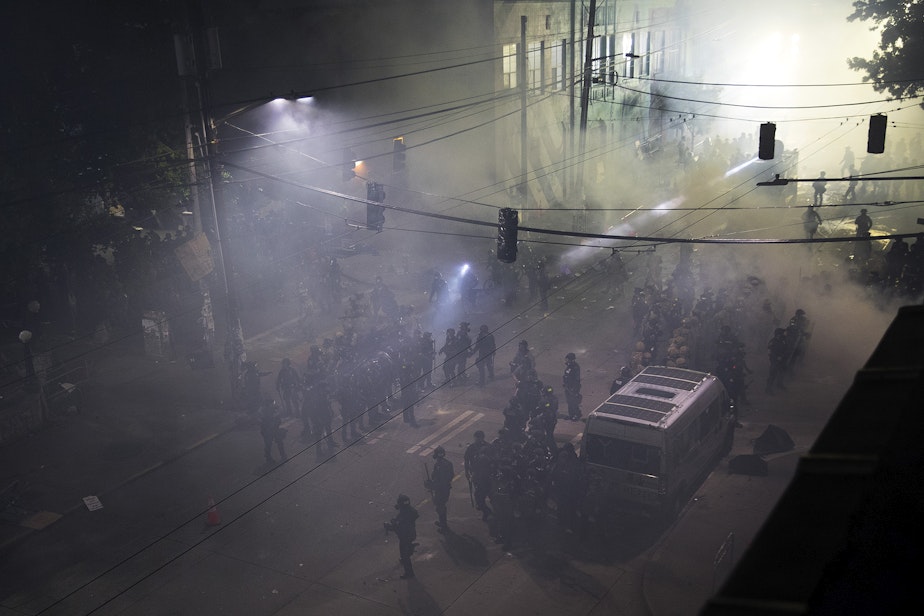Seattle police should change their response to protestors after tension last summer, report says

Tear gas choked the air and rubber bullets rang out for days on end last summer in Seattle as police responded to protests over racial injustices. A new report suggests that the response by Seattle police officers further inflamed tensions, and they should handle future protests differently.
KUOW’s Amy Radil told Paige Browning about the new analysis.
This interview has been edited for clarity.
Paige Browning: First, where did the analysis of the Seattle Police Department come from?
Amy Radil: This report is called a "Sentinel Event Review." It was created by a group of police and community members that were brought together by the city's Office of Inspector General. This particular report takes a deep dive on that first weekend of protests we saw in Seattle, May 29 to June 1.
Lisa Judge is the inspector general for Seattle. She told the city council today that she thought it was important that this group did include community members and police officers:
“Because at the end of the day, this report really is for SPD to take to heart and to make those changes to keep this from happening again.”
Sponsored
What was happening during that time that the Inspector General reviewed?
There was so much happening in just a few days span. That first weekend accounted for 20% of the Seattle Police Department's use of force related to protests for the rest of 2020. One part of this report that to me was interesting was on May 29 —there were protests in the Chinatown-International District. They didn't get as much attention, but the report says that this was really significant for what came in the next few days.
The report describes that well-organized, mostly white protesters did some property damage through a neighborhood of Asian American-owned businesses. Police, who were watching that, became really fearful about anarchists with criminal intent coming to Seattle or participating like this.
The community members’ version was the police were standing by, and that they would have intervened more if it had been people of color doing this damage. There was anger and fear amping up on multiple sides as this happened.
The review goes on to look at what happened next downtown: the child who was hit by pepper spray, the destruction of police vehicles, the police rifles getting stolen, and then the confrontations outside the East Precinct where police used tear gas on the demonstrators.
Sponsored
This review found that a lot of the things that the police did in response actually inflamed the protests: telling people to leave when they had no way to get out of downtown, for example; using tear gas on an entire crowd rather than focusing on the few people at the edges who were committing crimes. Overall, just not signaling that the police respected the right of those peaceful demonstrators to be there.
How could this change what we see at the next demonstrations in Seattle?
The report contains 54 recommendations, dozens and dozens of things to do differently. Lisa Judge says she expects the Seattle Police Department to formally respond to all of them. Some of them are things that the Seattle Police Department says they've already implemented. They have more of a PA system to make sure that people in the crowd can hear the instructions; trying not to inflame anti-police protest specifically by drawing back a bit; and they say they did get more effective at going after specific people committing crimes while protecting the rights of the larger crowd.
What does the report call for that the Seattle Police Department is not currently doing?
The Inspector General admitted this is a difficult moment for the Seattle Police Department to take on anything additional. They're confronting staffing shortages and increased gun violence in Seattle. One thing the report highlights is the importance of officer wellness; that the Seattle Police Department and the city need to focus on preventing the exhaustion and the stress that could be a factor in decision-making.
Sponsored
Another idea is to have dialogue officers at protests, who talk to the protesters before and during these events just to make better communication. The Seattle Police Department says they have done that in the past sometimes. That wasn't something protesters wanted that weekend, but this would take that approach a bit farther.
And one recommendation would be to change the Seattle Police Department's policy, which right now says they have to be neutral during demonstrations; to allow them to show support of protesters right to be there in a way that the panel said might have defused some of these tensions. They said at the very least they need to make sure officers who are disrespectful to protesters know that that's unacceptable.
Listen to the interview by clicking the play button above.





